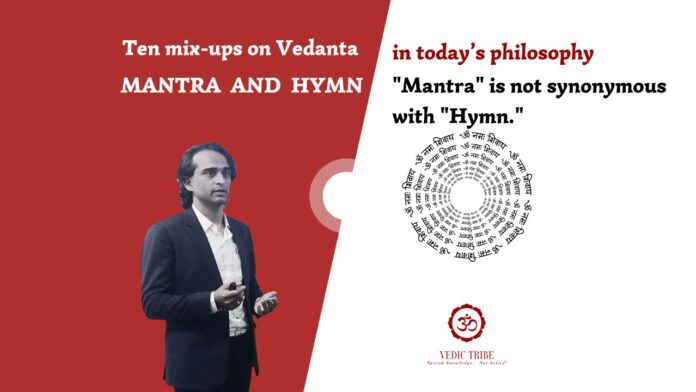“Mantra” is not synonymous with “Hymn.”
In the previous article, we discussed how the term “Yajna” is mistranslated to “sacrifice”. In this article, we will discuss – how the terms “mantra” and “hymn” are different.
While both are used to invoke spiritual feel and offer praise, they have distinct characteristics
Hymn:
Poetic: A hymn is a poetic composition, often sung or chanted, expressing praise or devotion to a deity or a concept. Let’s take the popular Christian hymn “Amazing Grace” as an example (first verse):
Amazing grace, how sweet the sound
That saved a wretch like me
I once was lost, but now I’m found
Was blind, but now I see.
Rhyme Scheme: The hymn follows an ABAB rhyme scheme, creating a rhythmic and memorable pattern.
Meter: The meter is iambic tetrameter, meaning each line has four metrical feet, each consisting of an unstressed syllable followed by a stressed syllable.
Expressing Praise and Devotion: The lyrics of “Amazing Grace” express gratitude and praise for God’s saving grace. It recounts a personal experience of redemption and transformation.
Format: The hymn is divided into verses, each conveying a specific message or theme. The verses often follow a repetitive structure, making it easy to learn and sing.
The verse: The verse adheres to the poetic structure, expresses deep devotion, and is easy to memorize and sing.
Mantra:
Esoteric: While some mantras may be poetic in form and may involve praise, they involve a deeper esoteric meaning. Ancient scholars like Yaska, classical Gurus like Sri Madhwacharya and modern scholars like Aurobindo have elaborately explained these esoteric meanings and laid down key principles for understanding these esoteric meanings.
Syllable: A mantra is a sacred sound, syllable, or phrase that is repeated to invoke deities, perform rituals, induce a specific mental state or spiritual experience. Mantras are often having a deeper, more esoteric meaning, and their recitation is considered to have transcendental powers. For instance – a single syllable “hrim” is considered a Beeja-Mantra; 24 syllable Gayatri Mantra is considered a Maha Mantra.
Meter (Chandas): Number of syllables in a mantra determines the Chandas. For instance fifth mantra in Purusha Sukta has 32 syllables & hence it is Anushtub Chandas. Every chandas has a deity and it purpose is to cover the esoteric meaning of a mantra.
Subjective experience: A mantra is not composed by humans. Instead, they are the linguistic representation of subjective experiences of Vedic sages. For instance, Gayatri Mantra is a linguistic representation of Sage Vishwamitra’s spiritual revelations.
For instance, Sri Aurobindo interprets the first mantra of Rigveda as follows:
Agni the brilliant I adore who standeth before the Lord, the god that hath the rapture of the truth, the fighter that fulfilleth utter bliss.
Differences:
– Hymn is poetic whereas Mantra is hardly poetic, rather is esoteric.
– Meter is observed in hymn for the purpose of making it singable. Meter in Mantra protects the esoteric meaning of the Mantra itself. Only with the grace of deity of the chandas and the deity of the mantra, the true meaning of the mantra is revealed.
– Hymn is designed for an emotional connect to the divine. Whereas Mantra is a linguistic representation of divine experiences of Rishis.
Key takeaways:
“Mantra” not ryhm: When you hear someone use “Vedic hymn” politely correct them to call it “Veda Mantra”. You may also convey why such difference exist.
Learn to chant Mantra: With proper Guru’s initiation, learn to chant Vedic mantras and experience its esoteric bliss.
In the next article, we will discuss the sixth mix-up – “Priest and Brahmin”.
Madhwesh K
Vedic Tribe

